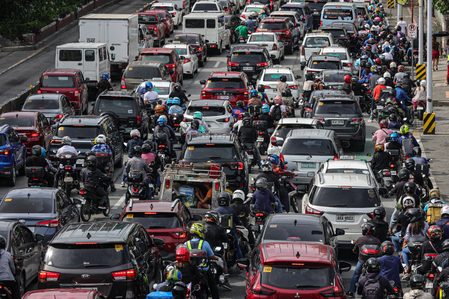
Upgrade to High-Speed Internet for only ₱1499/month!
Enjoy up to 100 Mbps fiber broadband, perfect for browsing, streaming, and gaming.
Visit Suniway.ph to learn
This is AI generated summarization, which may have errors. For context, always refer to the full article.

NEW CHIEF. President Ferdinand Marcos Jr congratulates new Philippine National Police Chief Nicolas Torre III, while outgoing Philippine National Police Chief Rommel Marbil looks on, during a handover ceremony in Camp Crame, on June 2, 2025.
Eloisa Lopez/Reuters
For not complying with his five-minute emergency response rule, the PNP chief removes not one, but eight police chiefs in Metro Manila
Philippine National Police (PNP) chief Police General Nicolas Torre III is a tough guy — there’s no question about that. But the newly-minted top cop has been tough on his soldiers, too.
For not meeting his orders, Torre sacked not one, but eight local police chiefs in Metro Manila, he announced on Monday, June 16.
The PNP chief ordered the relief of the chiefs of police of Caloocan, Makati, Mandaluyong, Marikina, Navotas, Parañaque, San Juan, and Valenzuela for failing to comply with his PNP order to respond to emergencies within five minutes.

Relieved means the police officers were removed from their posts, but are still part of the police service. They will likely be given another assignment.
The PNP chief said they did simulation exercises (SIMEX) to test the police’s ability to adhere to the five-minute response policy. After his SIMEX in Western and Central Visayas, and the Negros Island Region, Torre said he “cautioned” three provincial directors there. He said he will declare their posts vacant to replace them.
“So again, dahil priority ang Metro Manila, I’ll keep the exercise in Metro Manila at ‘pag di kayang gawin ng chief of police ‘yon sa kanyang station, aalisin ko siya,” the PNP chief said.
(So again, because Metro Manila is a priority, I’ll keep the exercise in Metro Manila and if the chief of police can’t do that in his station, I’ll relieve him.)
Even high-ranking police regional chiefs will not be spared if they underperform: “I have already spoken to the regional directors — their provincial directors, and chiefs of police are their responsibility. So ‘pag masyadong marami at nakita ko na kaya nagpe-fail ang mga chief of police at saka provincial directors, at mga district directors, ay nagpe-fail dahil kulang sa direksyon…ng regional directors (RD), aalisin natin ang RD.”
(So if there are too many chiefs of police, provincial directors, and district directors who are failing because of lack of direction from the regional directors, I’ll remove the RDs.)
Will the five-minute policy work?
Even before he appointed Torre as his fourth PNP chief and the first from the PNP Academy, Marcos said in May that his administration will implement the “Cops On the Beat” program, which aims to make more police visible in the streets.
He said they’re also centralizing emergency calls in the country and with the help of the “Cops On the Beat” program, police may be able to respond to an emergency within five minutes.
Shortly after his appointment, Torre spoke in Malacañang to promise that the PNP will respond to emergencies within the time promised by their commander-in-chief. The PNP chief ordered the removal of police boxes and police community precincts so that cops will be on the streets instead to respond quickly to calls.
Torre is not the first PNP chief to have launched such a quick response program.
In 2016, then-PNP chief Ronald dela Rosa launched an application called “Itaga mo sa Bato” to augment the existing 911 emergency response system in the country. Torre’s immediate predecessor, newly-retired PNP chief Rommel Francisco Marbil, also had his own quick response program.
But like any other police programs, like the mandatory body-worn cameras, the effectiveness of these initiatives — if there are any — have yet to be mainstreamed.
To be fair, there are a lot of factors, such as the short terms of PNP chiefs, since some past top cops were appointed with only less than a year to serve. This could be a hindrance to the continuation of programs.
There’s also the factor of traffic, since the country, especially Metro Manila, suffers from heavy traffic on a daily basis. In 2023, the country’s capital region traffic ranked as the world’s worst metro area traffic.
Torre has a long road ahead of him as he will serve until 2026. His promise of emergency response is among the first tests of his leadership. Will his hardline approach succeed? – Rappler.com

 5 hours ago
3
5 hours ago
3




